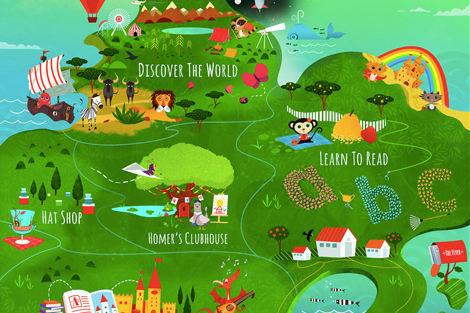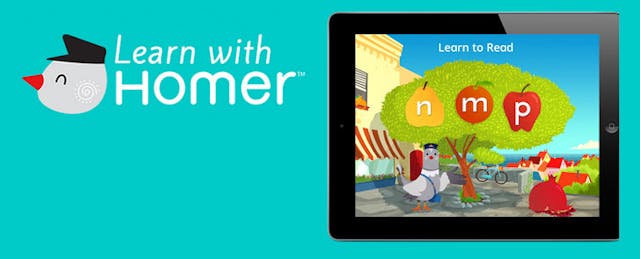When one of Stephanie Dua’s daughters began to learn to read, her lack of confidence got in the way. Like many mothers, Dua eagerly turned to apps: she hoped to find one that would comprehensively help her daughter master reading. When the apps came up short, Dua went a step beyond most other mothers: she decided to start a company to try to improve on what she sees as the “haphazard” approach to reading of so many apps. A year later, Learn with Homer is ready to go live on iPads.
Learn with Homer is very new; only about 75 beta testers have put it through its paces so far. Even so, as a long-time literacy teacher, I was intrigued by the company’s systematic approach to teaching reading. Learn with Homer is a comprehensive literacy experience for children ages 3- to 6-years old with phonemic awareness, classic literature, and integration of non-fiction texts that boost vocabulary and critical thinking.
Learn with Homer’s team has woven together a mix of 24 stories, folklore, poems, rhymes, folksongs, with 30 “Learn to Read” lessons and 33 “Discover” lessons focusing on nonfiction topics and vocabulary. It runs on the iPad. The name is a shout-out to the Greek poet, Homer. Dua’s startup has transmuted the poet into a clever mascot and main character, namely a pigeon poet named Homer.
Dua had plenty of background that helped: She spent five years as CEO of The Fund For Public Schools in NYC and nurtured her passion for literacy during several years when she worked and consulted with David Coleman on the Common Core Literacy Standards. All that work, it seems, was simply preparation for Learn with Homer, which she’s created with a team of 10 educators, artists, and developers. In an initial round of seed funding raised in early 2013, Dua raised $2.2 million from a prestigious list of angel investors.
My first question to Dua and her marketing partner, Keith Meacham, a former teacher, was simple: Who is the target user for this product? With such development muscle, I could imagine teachers would be tempted to use Learn with Homer.
Instead, Dua and Meacham say Learn with Homer is principally targeting parents and their young children for several reasons: it’s easier to get feedback and iterate with parents than it is with schools; it’s tough for a small edtech company to address both the parent and school markets well. And finally, Dua asserts that parents should be driving the kind of change in school programs that support teachers. Give parents a comprehensive literacy tool, she says, and they can become “real partners” in their children’s early education and even advocate for education quality.

There are four main segments of Learn with Homer along with the Hat Shop where kids can put on a “thinking cap” for their learning journey.
Learn to Read: This sequential section is aligned to Kindergarten Common Core Standards. Children can go slowly and repeat skills as needed; along the way, they complete challenges. There is a strong phonemic awareness component with multiple levels in all for kindergarten. Although the initial version of Homer will have only five levels, Dua plans to release 17 more levels once she sees how children work through the initial ones.
The killer feature is an interactive element that lets students view a video of how to pronounce a letter sound and then record themselves emulating that skill. In this section, phonemic awareness skills are woven together into literature with a poem, which further integrates the skills.
At the end of each lesson, students are prompted with a question that encourages them to complete a recording and a drawing. These creations are captured on a child’s “pinboard,” which they can retrieve in Homer’s Clubhouse. Parents can see and comment on these creative gems on the website in a way that keeps the “parent view” completely separate from the child’s adventure.
Discover the World: Children encounter non-fiction segments aimed at helping them build vocabulary and knowledge, a key component of the Common Core Standards.
These segments are included via thematic packs featuring six lessons a piece. Dua describes the app as both “linear and non-linear,” weaving into lessons the nonfiction piece with the characters, asserting that powerful learning occurs across domains. As a literacy coach I agree with Dua’s observation that “it’s critical for kids to wrestle with complex ideas before they are actually able to read.” Understanding, for example, the concept of a “predator,” while reading the folk tale, The Lion and the Mouse, provides children with the precursors to critical thinking.
Homer’s Clubhouse: This is where kids can create artwork and store recordings accessible also on the parent website. Parents can leave voice and written comments for their children.
Story time: This library of classic literature unlocks stories as children progress through the lessons. Dua says she wants the illustrations of classics to have the same punch as the popular media children currently experience. While Homer houses 24 poems, folk songs, folk tales, and original stories, myths and fairy tales will be part of future releases.
The teacher in me must ask: So what about writing? Dua expects that by September 2013, students will be able to trace words on the “drawpad” where they currently respond to lesson prompts. Eighty printable worksheets on the parent website will provide some writing skills practice. Writing is a complex proposition for sure, and though this may address letter formation and writing words, I sincerely hope that a wider range of writing skills will be more completely addressed in Homer’s future plans.
Learn with Homer’s pricing model appears like it will work well for families as a free app with 30 lessons included. These include two "Learn to Read" levels and two "Discover the World" packs. Up to three children can use one account. Homer’s "Clubhouse" is free, and includes storage for up to 500 recordings and drawings per child. Additional content is available via In-App purchase, bundled as “levels” each for $1.99 and “packs” with a discounted price of $5.99 for multi-pack purchases.
I can’t help but add my teacher two cents and say that I truly hope that Learn with Homer finds its way into the classroom so that all children can benefit from it. There are a couple of major barriers, including the $1.99 cost of additional in app purchases and the sign on for only three users per account. Teachers will need a way to register 20 to 30 students as well as a dashboard to track progress.
So the big question? Did Homer help build Dua’s reading confidence and unblock the way? Dua gives an emphatic yes. All three of Dua’s daughters, in fact, can’t get enough of Homer, she says. Her most reluctant reader has transformed into a voracious reader and a huge fan of family read-aloud time with Anne of Green Gables and House on Pooh Corner among the favorites. Poet pigeons can certainly make a difference. Who knew?


